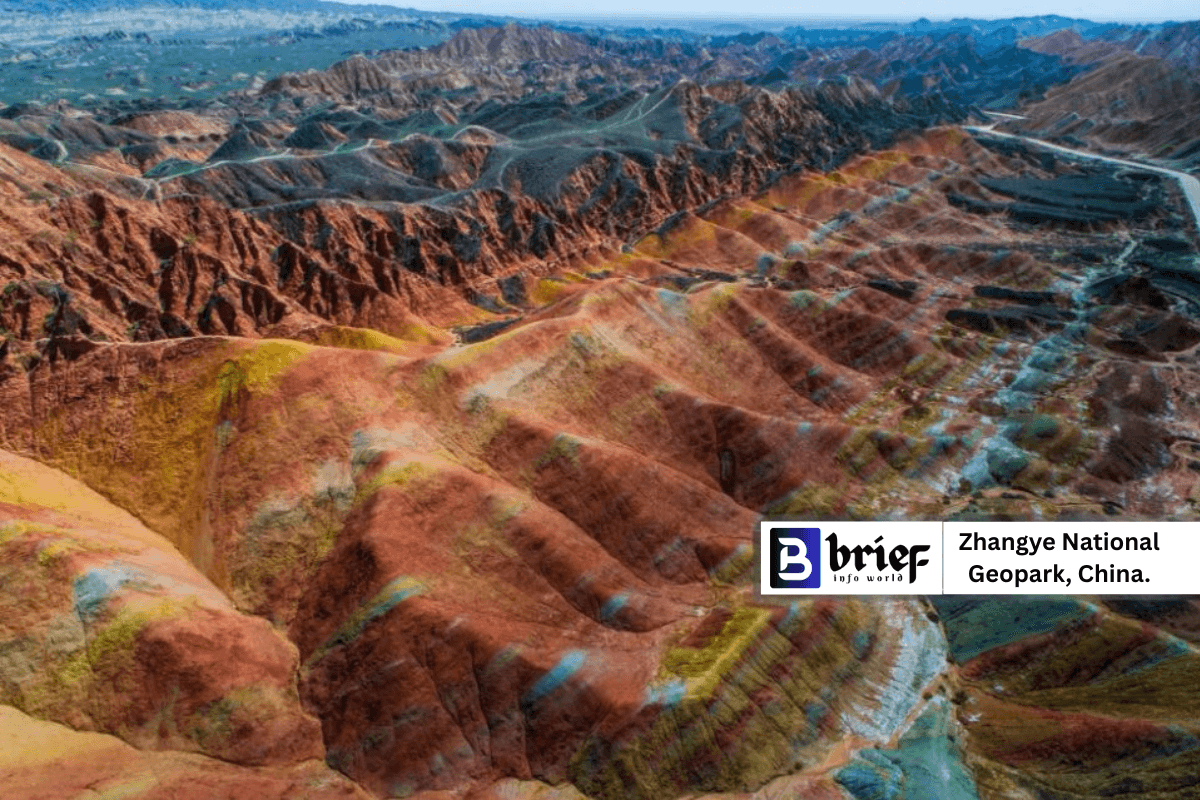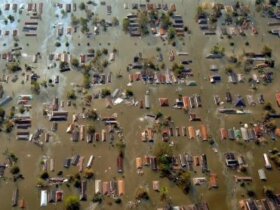Hurricane Erin—the name has repeatedly returned to the Atlantic basin, leaving a distinct mark on each iteration. Sometimes symbolizing terrible destruction, sometimes silently disappearing into the ocean. This cyclone has made its presence known at various stages of human history. From the devastating storm of 1995 to the mysterious presence during 9/11 in 2001 and even the most recent hurricane of 2025, each ‘Erin‘ is not just a natural disaster. But a living testament to humanity’s resilience, technological advancement, and our relationship with nature.
What is a hurricane, and why is the name ‘Erin’ so important?

A hurricane is a severe tropical cyclone that forms in the Atlantic and northeastern Pacific Oceans. It is called a hurricane when its rotational wind speed exceeds 74 miles per hour (119 kilometers per hour). These cyclones usually accumulate energy from warm ocean waters and can cause widespread destruction when they hit coastal areas.
The World Meteorological Organization names hurricanes, which rotate according to a specific list. The name ‘Erin’ is on the list of Atlantic hurricanes,. So more than one storm has been named with this name at different times. However, the character and impact of each storm were different, which gave ‘Hurricane Erin’ a multifaceted identity.
Tropical Storm Erin of 2025: Present and Future
A storm named ‘Erin’ reappeared in the Atlantic in August 2025. It emerged with the potential to become the first hurricane of the season. Although it was not as destructive as the previous two storms. Its appearance sparked renewed global discussions about climate change and the increasing risk of hurricanes.
Track and Forecast
Erin of 2025 formed as a tropical storm near the Cape Verde Islands in Africa. Due to warm ocean waters, meteorologists predict that it could quickly gain strength and become a powerful hurricane. Its likely path was towards the Caribbean islands and the east coast of the United States.
This forecast caused concern among people in coastal areas. Memories of 1995 and the fear of increasing hurricane intensity due to climate change haunted them. Governments and disaster management agencies issued early warnings and urged people to prepare.
Climate change context
In recent years, scientists have noticed that hurricanes are becoming more powerful and destructive due to rising sea temperatures. The emergence of Erin in 2025 supports this theory. Erin exemplifies how quickly a tropical storm can turn into a major hurricane.
This event reminds us that the effects of climate change are no longer a theoretical matter, but a harsh reality of our daily lives. Rising sea levels, warming, and extreme weather events have greatly challenged humanity.
Hurricane Erin of 2001: Silent Witness to 9/11

Hurricane Erin was the first and longest-lasting hurricane of the 2001 hurricane season. But the storm is better known not for its strength or destruction. But for its unique geographical location and connection to a dark chapter in history.
A lonely, powerful storm
Erin, which formed in the Atlantic in early September, gradually strengthened and became a Category 3 hurricane. Its maximum sustained winds were 120 miles per hour (195 kilometers per hour). Fortunately, however, this powerful hurricane spent most of its life cycle far from land, at sea.
Erin had some impact on Bermuda as it passed very close to it. Although strong winds and high waves caused some damage, Bermuda was spared major damage.
9/11 and Hurricane Erin: A Strange Connection
On September 11, 2001, when the terrorist attacks on the World Trade Center in New York City were carried out, Hurricane Erin was in the Atlantic Ocean, not far from the New York coast.
That day, New York’s skies were unusually clear and bright blue. Meteorologists say one reason for this was Hurricane Erin’s presence. The interaction of Erin and a cold air current removed all the moisture and clouds from the air in New York City.
But the most surprising thing was elsewhere. The huge amount of smoke and dust emitted from the ruins of the World Trade Center was pushed south, towards the sea, by Hurricane Erin’s swirling winds rather than spreading towards the city. Many experts believe this resulted in a somewhat lower concentration of toxic particles in the air in New York City, and many more people were spared from the terrible health risks.
This event gave rise to a strange mystery of nature. The hurricane that could have been a symbol of destruction indirectly saved humanity to some extent on the day of a great disaster. Erin is therefore also called the ‘Forgotten 9/11 Hurricane’.
Hurricane Erin of 1995: Double Strike on Florida’s Heart

The 1995 Atlantic hurricane season was active, and Erin was the second hurricane. This hurricane is particularly memorable because it hit the Florida coast twice, a rare occurrence.
Birth and Path
Hurricane Erin formed from a tropical wave near the Bahamas in late July. On July 31, it became a tropical storm and rapidly strengthened to a Category 1 hurricane on August 1.
Erin first landed on the east coast of Florida, near Vero Beach. After landfall, it weakened slightly to a tropical storm and crossed the Florida peninsula into the Gulf of Mexico. As it came into contact with warmer waters, Erin regained strength and became a Category 2 hurricane.
August 3, 1995. Hurricane Erin made its second landfall in Pensacola Beach, in the Florida Panhandle. This time, it was even more powerful. Winds were 100 miles per hour (160 km/h).
Human Experience: The Fight for Survival
As Hurricane Erin approached Florida, panic and uncertainty gripped the nation. For those who had never experienced a hurricane, it was a new and terrifying experience.
“I remember the roar of the wind, like a train,” recalls James, a Pensacola resident. “We took shelter in the bathroom of our house. Every moment, it felt like the roof was going to come off. There was the sound of vandalism coming from outside. It was a terrifying night.”
Erin left nearly a million people without power and damaged thousands of homes. The worst damage was in Brevard County and the Florida Panhandle. Trees were uprooted, roads were blocked, and floodwaters flooded low-lying areas.
But Erin was not just a story of destruction, but also a great example of unity and compassion among people. Neighbors came to each other’s aid. After the storm, rescue workers and the public worked together to clear roads, repair damaged homes, and distribute food and water.
Economic and social impact
Hurricane Erin caused an estimated $700 million in damage. Agriculture, especially cotton and pecan crops, suffered significant damage. The tourism industry was also severely affected. Beachfront shops, hotels, and other infrastructure were damaged, leading to a decline in tourist arrivals.
The hurricane tested Florida’s disaster management system. After Erin, building codes in coastal areas were tightened, and new programs were launched to educate people about hurricanes.
What have we learned from Hurricane Erin?

The different forms of Hurricane Erin have taught us a lot. These lessons are not limited to dealing with hurricanes but also affect our lifestyles, technology, and relationship with nature.
- The Importance of Preparation: Hurricane Erin in 1995 taught us how important it is to be prepared for natural disasters like hurricanes. Building strong shelters, early warning systems, and public awareness can save many lives.
- Use of Technology: Satellites and computer modeling have revolutionized hurricane forecasting and tracking. In the case of Erin in 2001 and 2025, we saw how advanced technology helps us get early warning and reduce damage.
- The Power of Humanity: Hurricane Erin is a shining example of how people stand by each other during a disaster. This united effort of people, regardless of race, religion, or color, is our greatest strength.
- Respect for Nature: Hurricane Erin repeatedly reminds us of the immense power of nature. Erin’s role in the 9/11 incident is an example of the mystery of nature. It teaches us that humanity should live in harmony with nature rather than at war.
Hurricane Erin FAQ
Question 1: Will the name ‘Erin’ be used again?
Answer: The list of hurricane names is updated every six years. That name is removed from the list if a hurricane is extremely destructive. The name ‘Erin’ has not yet been removed, so hurricanes with this name may reappear.
Question 2: How many deaths were caused by Hurricane Erin?
Answer: About 16 people died due to Hurricane Erin in 1995. Some of these deaths were caused directly by the storm, and some indirectly. No direct casualties were reported due to Erin in 2001 and 2025.
Question 3: How are hurricane categories determined?
Answer: The ‘Saffir-Simpson Hurricane Wind Scale’ is used to measure the intensity of a hurricane. Hurricanes are classified into five categories, from 1 to 5, based on wind speed. Category 5 is the strongest hurricane.
Question 4: Is climate change making hurricanes more dangerous?
Answer: Yes, according to scientists, global warming is increasing the temperature of ocean water, which is giving hurricanes more power. As a result, hurricanes are becoming more intense and longer-lasting, and the amount of rain that comes with them is also increasing.
Question 5: What steps should be taken to avoid a hurricane?
Answer: If a hurricane is predicted, it is very important to move to a safe shelter, close the doors and windows of the house tightly, keep the necessary food, water, and medicine in stock, and follow official instructions.
Conclusion
Hurricane Erin is not just a name; it is a history. This history speaks of fear, destruction, the struggle for survival, and the complex relationship between humans and nature. From the devastation of 1995 to the mysterious presence of 2001 and the warning of 2025, each Erin reflects our times.
The story of Hurricane Erin is an important lesson for everyone worldwide. It teaches us about resilience, preparedness, and respect for nature. In this era of climate change, when the number and intensity of natural disasters are increasing daily, the history of cyclones like Hurricane Erin shows us the way forward. This path is the path to building a safe and sustainable world by respecting the power of nature, using technology wisely, and embracing human values. Just as the sky clears after a storm, each disaster makes us stronger and more united.

Hi, I’m M Saif, a digital marketer with a strong focus on SEO and content writing. I help businesses improve their online visibility, drive organic traffic, and create engaging content that converts. With a results-driven approach, I work on strategies that not only boost rankings but also deliver real value to audiences.












Leave a Reply